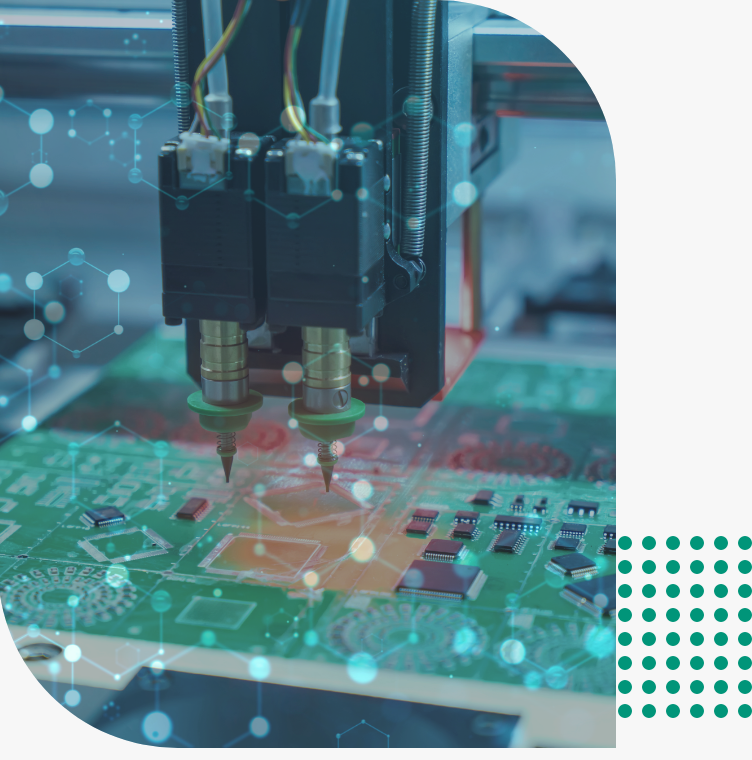Two-Component Dispensables in Thermal Management
In an article published earlier this fall, Polymer Science considered how important compaction and designing more effective thermal management materials helps advance electronics. Polymer Science engineers design a number of thermal management materials including phase change materials and silicone gap fillers. Specifically, thermal interface materials like two-component dispensable gap fillers help reduce weight, lower impedance for better heat flow and effectively dissipate heat across smaller gaps. Exploring two-part dispensables in further depth, Polymer Science illuminates the positive impact for electronic manufacturer’s design, manufacturing processes and return on investment through the use of P-THERM® thermal management materials.
Defining Two-part Dispensable Gap Fillers
Polymer Science uses Two-part platinum cure chemistry. As the name indicates, these are applied in a liquid state as two components. The application is extremely accurate and precise. There are two primary problems Polymer Science’s P-THERM® Two-part dispensables solve: managing higher energy requirements and using less material than conventional solid gap fillers. Throughout most industries, electronic components are becoming more compact and performance demands are increasing. In other words, high-performance demands coupled with higher energy density requires a thermally conductive material with low thermal impedance.
Ideally suited for mating heat-producing surfaces to a heat sink, there are a number of applications and manufacturing processes that benefit from the low weight, thin bond lines and form-in-place qualities of Two-part silicone dispensables.
Before we explore other applications that can benefit from two-part dispensables, another key quality must be acknowledged. Two-component dispensable gap fillers are tunable by Polymer Science. Designed to cure in place at room temperature, dispensable silicone gap fillers can be tuned to suit the manufacturing process including curing time and viscosity. These qualities mean Two-part dispensable gap fillers can be applied in the most intricate applications and complex manufacturing processes. Wherever you need to manage heat, Two-part dispensables are highly effective as a precise application.
Applications of Two-part Dispensables
There are broad uses for Two-part dispensables as thermal management materials across many industries. Instead of speculating broadly about EV vehicles, aerospace or consumer electronics, let’s examine how substituting Two-part dispensables for thermal pads and thermal grease in specific components benefits increasing energy density, manufacturing processes and return on investment (ROI).
Printed Circuit Boards (PCBs)
The three most common thermal solutions in PCBs include putty gap fillers, viscoelastic materials and dispensables. Dispensables can be poured across a circuit board providing almost no stress and even contact across sensitive components to provide a dielectric barrier, broad thermal protection and shock management or strategically applied where heat management may be a concern. Viscosity control during application and cure to prevent cold flow helps address the issue of creep which must be considered when selecting putty gap fillers and viscoelastic materials. Stress during compression is minimized as the material may still be liquid or only semi-cured during assembly. A final performance consideration is lower impedance from Two-part dispensables compared to other gap fillers. As a liquid application, dispensables cover irregular surfaces, and when cured, these materials fill small air gaps and natural or machined irregularities in the PCB component’s surface.
The manufacturing benefits include using less material and precise control of the material. While the equipment to set up Two-part dispensables is higher in initial price than solid gap fillers, the flexibility to only use the volume of material you need benefits long-term ROI. Productivity may improve because applications can be integrated into the automation process. Finally, the defect rates are reduced by the precision of the application.
Advanced Battery Applications
Dispensables are invaluable in advanced batteries. As a gap filler between individual battery cells, dispensables provide effective thermal management to heat sinks and improve mechanical stability and dampen shocks. From an engineering perspective, optimizing thermal conductivity, minimizing electrical conductivity and tuning dispensables to align with performance requirements is valuable. From design and manufacturing perspectives, reducing materials while improving performance benefits advanced batteries. Dispensables can be used throughout advanced batteries between individual cells and the module housing and again between the module housing and the external pack.
Electric Vehicles (EV)
As the present and future of mobility transforms to electrification, weight reduction is key to improving performance in electric vehicles. Conventional solid gap fillers are thicker and the material is heavier. Dispensable gap fillers transfer heat using less material and fill small gaps. The reduced weight greatly impacts the performance of electric vehicles.
When considering manufacturing, the application of dispensable is very precise, and the thin bond lines offer lower thermal impedance across small gaps than other gap fillers. During complex manufacturing processes, the ability to tune curing time to suit the process is a major benefit. Polymer Science works with manufacturers to design dispensables to meet the needs of manufacturing and focus on long-term performance within EV and other mobile applications.
There is a high level of stress involved with EVs. Dispensables provide a dependable long-term interface material. Unlike thermal grease, there is minimal outgassing. Compression concerns of solid gap filler pads are reduced when dispensables are used. In addition to excess heat triggering a thermal runaway event within battery cells, EV power converters need thermal management solutions. EV power converters convert stored energy within the batteries into usable energy throughout the vehicle. Dispensables are effective as a thermal interface material in these components.
Broader Applications
At Polymer Science, we see thermal management materials as a critical solution to the electrification of lightweight vehicles. Without speculating on the future, thermal management materials will need to evolve further to meet the needs of engineers and designers. Increased energy density applies to nearly every electric component. We are eager to learn more about the present and future needs of manufacturers.

